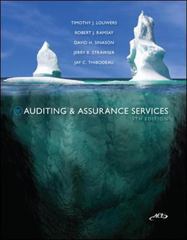Question
Cornerstone Exercise 11.3 (Algorithmic) Activity-Based Customer Costing Deeds Company sells custom-made machine parts to industrial equipment manufacturers by bidding cost plus 40 percent, where cost
| Cornerstone Exercise 11.3 (Algorithmic) Activity-Based Customer Costing Deeds Company sells custom-made machine parts to industrial equipment manufacturers by bidding cost plus 40 percent, where cost is defined as manufacturing cost plus order processing cost. There are two types of customers: those who place small, frequent orders and those who place larger, less frequent orders. Cost and sales information by customer category is provided below.
Order-filling capacity is purchased in steps (order-processing clerks) of 1,000, each step costing $50,000; variable order-filling activity costs are $30 per order. The activity capacity is 43,000 orders; thus, the total order-filling cost is $3,437,000 [(43 steps $50,000) + ($30 42,900)]. Current practice allocates ordering cost in proportion to the units purchased. Deeds recently lost a bid for 150 units. (The per-unit bid price was $2 per unit more than the winning bid.) The manager of Deeds was worried that this was a recurring trend for the larger orders. (Other large orders had been lost with similar margins of loss.) No such problem was taking place for the smaller orders; the company rarely lost bids on smaller orders. Required: 1. Calculate the unit bid price offered to Deedss customers assuming that order-filling cost is allocated to each customer category in proportion to units sold. Round your answer to the nearest cent. $ 2. Assume that a newly implemented ABC system concludes that the number of orders placed is the best cost driver for the order-filling activity. Assign order-filling costs using this driver to each customer type and then calculate the new unit bid price for each customer type. Round the amount of order cost allocation to the nearest whole dollar. Round other computations and the bid price to the nearest cent.
3. What if Deeds offers a discount for orders of 39 units or more to the frequently ordering customers? Assume that all the frequently ordering customers can and do take advantage of this offer at the minimum level possible. Compute the new order cost allocation and bid price. In your calculations, round the number of steps to the nearest whole number. Round the amount of order cost allocation to the nearest whole dollar. Round other computations and the bid price to the nearest cent.
| |||||||||||||||||||||||||||||||||||||||||||||||||||||||||||||||||||||||||||
Step by Step Solution
There are 3 Steps involved in it
Step: 1

Get Instant Access to Expert-Tailored Solutions
See step-by-step solutions with expert insights and AI powered tools for academic success
Step: 2

Step: 3

Ace Your Homework with AI
Get the answers you need in no time with our AI-driven, step-by-step assistance
Get Started


